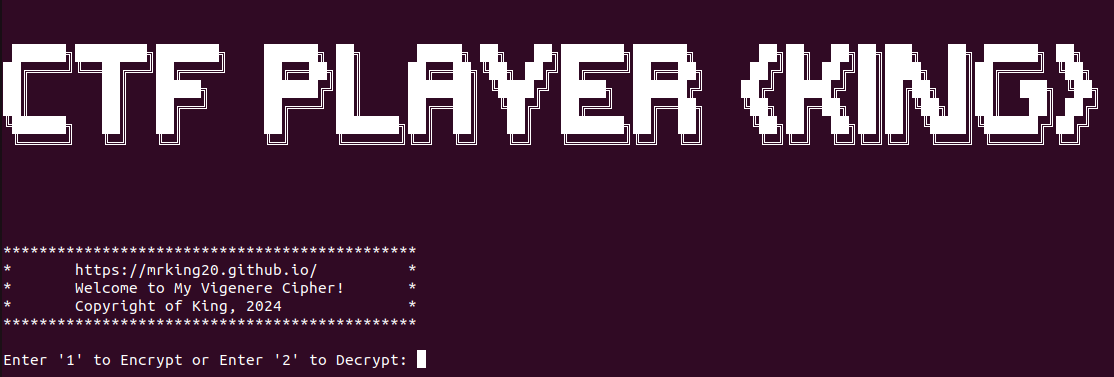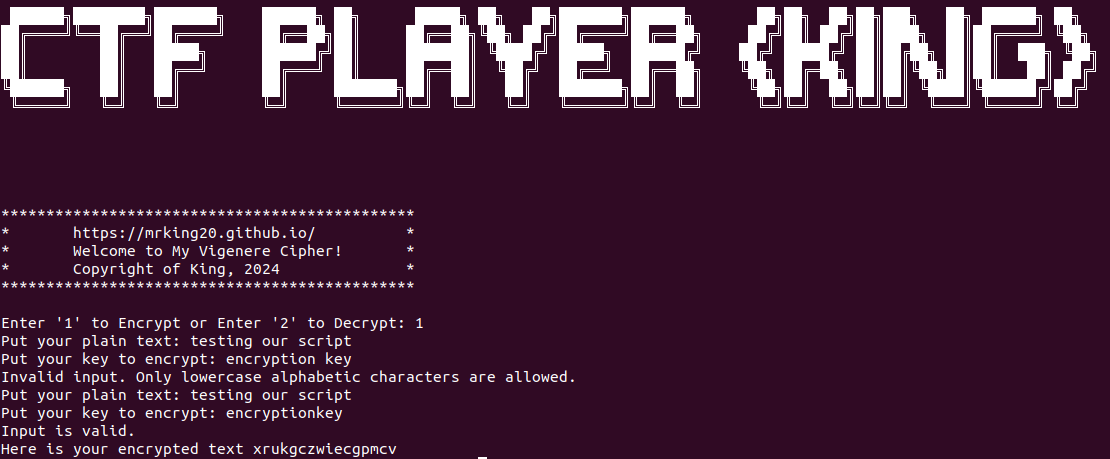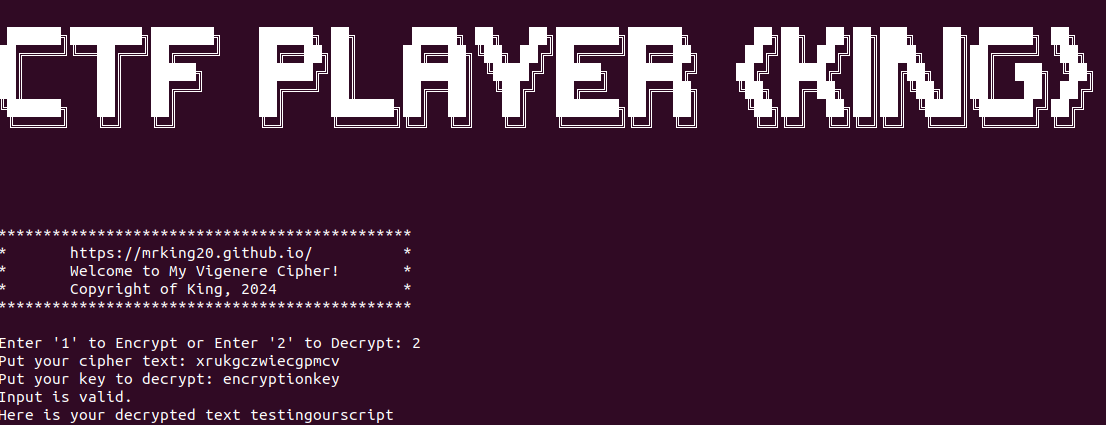Vigenère Cipher
This post features a simple Python script that demonstrates how to encrypt and decrypt messages using the Vigenère cipher, a classic polyalphabetic substitution method used in historical cryptography.
Description
By entering a keyword, users can easily encode or decode text. This project is perfect for anyone looking to learn the basics of encryption and understand how shifting characters based on a repeating key works.
The full Python code is included below, with examples of both encryption and decryption.
🔐 A fun way to explore foundational cryptography concepts with just a few lines of Python!
1
2
3
4
5
6
7
8
9
10
11
12
13
14
15
16
17
18
19
20
21
22
23
24
25
26
27
28
29
30
31
32
33
34
35
36
37
38
39
40
41
42
43
44
45
46
47
48
49
50
51
52
53
54
55
56
57
58
59
60
61
62
63
64
65
66
67
68
69
70
71
72
73
74
75
76
77
78
79
80
81
82
83
84
85
86
87
88
89
90
91
92
93
94
95
96
97
98
99
100
101
102
103
104
105
#cipher = (key + plain) mod 26
#plain = (cipher - key) mod 26
#BY The "KING"
print(r"""
██████╗████████╗███████╗ ██████╗ ██╗ █████╗ ██╗ ██╗███████╗██████╗ ██╗██╗ ██╗██╗███╗ ██╗ ██████╗ ██╗
██╔════╝╚══██╔══╝██╔════╝ ██╔══██╗██║ ██╔══██╗╚██╗ ██╔╝██╔════╝██╔══██╗ ██╔╝██║ ██╔╝██║████╗ ██║██╔════╝ ╚██╗
██║ ██║ █████╗ ██████╔╝██║ ███████║ ╚████╔╝ █████╗ ██████╔╝ ██╔╝ █████╔╝ ██║██╔██╗ ██║██║ ███╗ ╚██╗
██║ ██║ ██╔══╝ ██╔═══╝ ██║ ██╔══██║ ╚██╔╝ ██╔══╝ ██╔══██╗ ╚██╗ ██╔═██╗ ██║██║╚██╗██║██║ ██║ ██╔╝
╚██████╗ ██║ ██║ ██║ ███████╗██║ ██║ ██║ ███████╗██║ ██║ ╚██╗██║ ██╗██║██║ ╚████║╚██████╔╝██╔╝
╚═════╝ ╚═╝ ╚═╝ ╚═╝ ╚══════╝╚═╝ ╚═╝ ╚═╝ ╚══════╝╚═╝ ╚═╝ ╚═╝╚═╝ ╚═╝╚═╝╚═╝ ╚═══╝ ╚═════╝ ╚═╝
**********************************************
* http://nidhal-mabrouk.tech/ *
* Welcome to My Vigenere Cipher! *
* Copyright of King, 2024 *
**********************************************
""")
alp = 'abcdefghijklmnopqrstuvwxyz'
#This loop to create a new key has a same length as the plain text or cipher text
def samelength(c_np,k):
nk = k
for j in range(len(c_np)):
for i in range (len(k)):
if len(nk) != len(c_np):
nk += k[i]
else:
break
return nk
#Encryption Phase:
def encrypt(plain,key):
np = plain.replace(" ", "") #to remove spaces from the plain text
nk = samelength(np, key)
cipher = ""
for k in range(len(nk)):
ck = ((alp.find(nk[k]) + alp.find(np[k])) % 26)
cipher += alp[ck]
print("Here is your encrypted text",cipher)
#Decryption Phase:
def decrypt(cipher,key):
nk = samelength(cipher,key)
plain = ""
for k in range(len(nk)):
pk = ((alp.find(cipher[k]) - alp.find(nk[k])) % 26)
plain += alp[pk]
print("Here is your decrypted text",plain)
def validate_input():
var = input("Enter '1' to Encrypt or Enter '2' to Decrypt: ")
while True:
if var == '1':
plain = input("Put your plain text: ").lower() # Convert to lowercase to match the alphabet
key = input("Put your key to encrypt: ").lower() # Convert to lowercase to match the alphabet
# Check if all characters in 'plain' and 'key' are in the alphabet
if all(c in alp + " " for c in plain) and all(c in alp for c in key):
print("Input is valid.")
encrypt(plain, key)
break # Exit the loop if the condition is met
else:
print("Invalid input. Only lowercase alphabetic characters are allowed.")
continue
elif var == '2':
cipher = input("Put your cipher text: ").lower()
key = input("Put your key to decrypt: ").lower()
# Check if all characters in 'cipher' and 'key' are in the alphabet
if all(c in alp for c in cipher) and all(c in alp for c in key):
print("Input is valid.")
decrypt(cipher, key)
break # Exit the loop if the condition is met
else:
print("Invalid input. Only lowercase alphabetic characters are allowed.")
continue
else:
print("Invalid choice. Please enter '1' for encryption or '2' for decryption.")
var = input("Enter '1' to Encrypt or Enter '2' to Decrypt: ") # Ask again if input is invalid
validate_input()
Encryption
Decryption
This post is licensed under CC BY 4.0 by the author.


